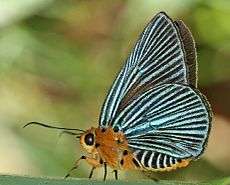Burara amara
| Small green awlet | |
|---|---|
 | |
| Male (above), female (middle), male underside (lower) | |
| Scientific classification | |
| Kingdom: | Animalia |
| Phylum: | Arthropoda |
| Class: | Insecta |
| Order: | Lepidoptera |
| Family: | Hesperiidae |
| Genus: | Burara |
| Species: | B. amara |
| Binomial name | |
| Burara amara (Moore, 1865)[1] | |
| Synonyms | |
|
Ismene amara Moore 1865[1] | |
Burara amara, the small green awlet,[2] is a species of hesperid butterfly found in Northeast India and Southeast Asia. The butterfly has been reassigned to the genus Burara by Vane-Wright and de Jong (2003) and is now Burara amara.[3]
Range
The small green awlet ranges from India, (Sikkim eastwards through Assam), to Myanmar, Thailand, Laos, Hainan and south Yunnan. It is also found in the Andaman islands.[2]
The type locality is northeast Bengal.[1]

At Mount Harriet National Park in the Andamans
Status
It is rare in the Himalayas and very rare in the Andamans.[4]
Description
The butterfly has a wingspan of 45 to 55 mm.[4]
Edward Yerbury Watson (1891) gives a detailed description:[5]
Male and female. Upperside brown with a greenish gloss; costal streak of forewing ochreous yellow in the male, less prominent in the female; male with a blackish subbasal patch. Cilia of both wings short and brownish white. Body dark brown; abdomen with greyish segmental bands. Underside, forewing brown, becoming bluish black along the base of the costa; posterior margin broadly brownish white; hindwing bluish black; veins of both wings brownish white, the space between them having a greyish blue parallel line running their entire length. Both wings also with the black ochreous-yellow-encirled basal spot. Thorax in front and beneath, head, palpi, legs, middle of abdomen, and anal tuft ochreous yellow. Femora and tibiae with a black spot; sides of abdomen black, the segmental bands prominent, Cilia greyish.
Habits
It is crepuscular.[3]
Cited references
- 1 2 3 Card for Burara amara in LepIndex. Accessed 16 October 2007.
- 1 2 Markku Savela's website on Lepidoptera Page on Bibasis genus.
- 1 2 Vane-Wright and de Jong (2003) (see TOL web pages on genus Bibasis and genus Burara in the Tree of Life Web Project) state that Bibasis contains just three diurnal species, the crepuscular remainder having been removed to Burara. The species now shifted to Burara are morphologically and behaviorally distinct from Bibasis, within which many authors have formerly included them.
- 1 2 Evans, W.H. (1932). The Identification of Indian Butterflies (2nd ed.). Mumbai, India: Bombay Natural History Society. p. 319, ser no I 2.16.
- ↑ Watson, E. Y. (1891) Hesperiidae indicae.
See also
- Hesperiidae
- Coeliadinae
- List of butterflies of India (Coeliadinae)
- List of butterflies of India (Hesperiidae)
References
- Evans, W.H. (1932). The Identification of Indian Butterflies (2nd ed.). Mumbai, India: Bombay Natural History Society.
- Watson, E. Y. (1891) Hesperiidae indicae. Vest and Co. Madras.
Online
- Beccaloni, George; Scoble, Malcolm; Kitching, Ian; Simonsen, Thomas; Robinson, Gaden; Pitkin, Brian; Hine, Adrian; Lyal, Chris. "The Global Lepidoptera Names Index (LepIndex)". Natural History Museum, London. Retrieved 2016-10-15.
- Brower, Andrew V. Z. and Warren, Andrew, (2007). Coeliadinae Evans 1937. Version 21 February 2007 (temporary). http://tolweb.org/Coeliadinae/12150/2007.02.21 in The Tree of Life Web Project, http://tolweb.org/
- "Markku Savela's website on Lepidoptera".
This article is issued from
Wikipedia.
The text is licensed under Creative Commons - Attribution - Sharealike.
Additional terms may apply for the media files.